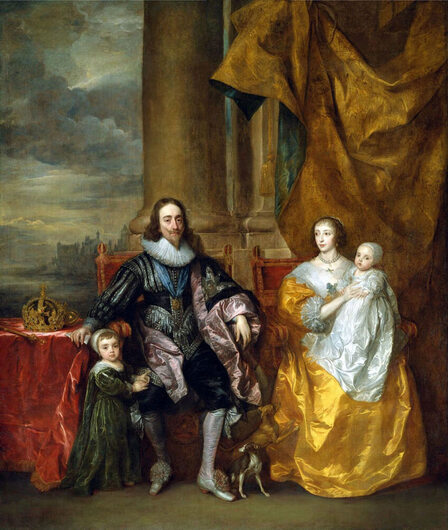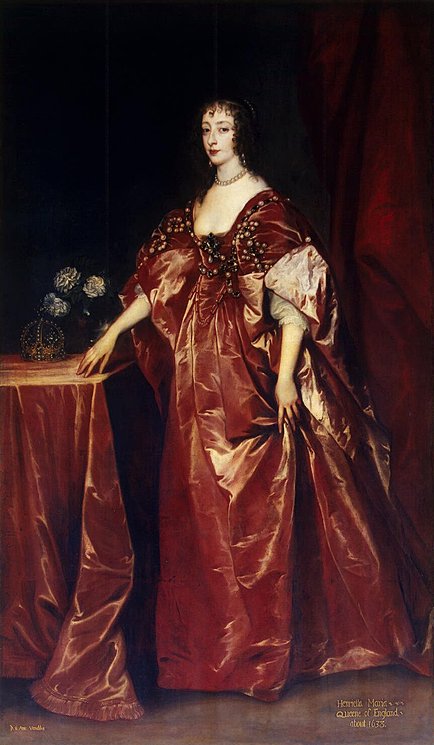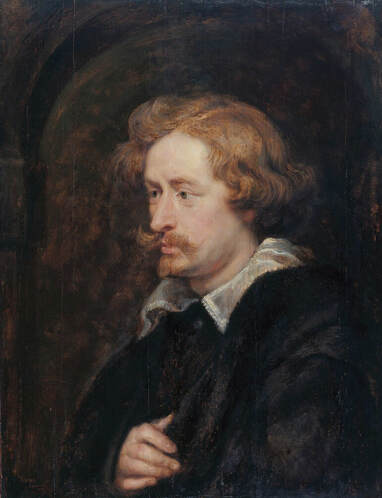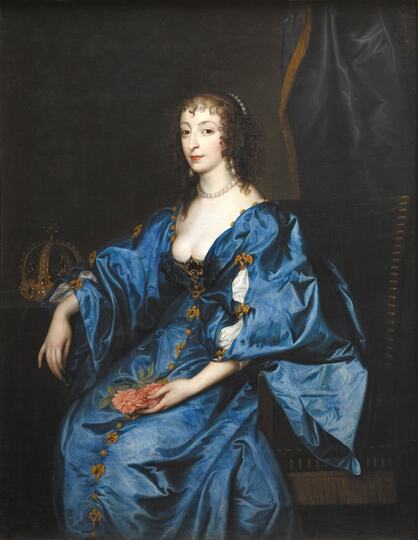|
Where? Room 17 of theSan Diego Museum of Art. A copy of this work is on display in the Statens Museum for Kunst.
When? c. 1636-1638 Commissioned by? King Charles I and Queen Henrietta Maria What do you see? A portrait of Henrietta Maria, the Queen of England. She sits on a chair wearing an elaborate blue satin dress which is decorated with jewelry, including a large brooch at her chest and several pieces of jewelry in the form of a fleur-de-lis (a Catholic symbol especially popular in Henrietta Maria’s birth country of France. She also wears a very expensive pearl necklace, earrings, and a diadem. She had received these pearl jewelry from her mother when she married. In her left hand, the queen has two pink roses. This was her favorite type of flower, and she wanted roses to be included in many of her portraits. On the left, her crown stands on a table. Finally, notice the long pointy fingers of Henrietta Maria, an aesthetic feature considered beautiful during that time. Backstory: Anthony van Dyck painted many portraits of Queen Henrietta Maria. However, the queen did not pose extensively for each of these portraits. Usually, she posed briefly for Van Dyck such that he could draw the outline of her portrait. The queen was then replaced by a stand-in model who would wear the same clothes as the queen. Van Dyck idealized the portrait of the queen. In reality, she was less pretty than she appears on these portraits; she was a short woman, but Van Dyck makes her appear as rather tall. The willingness of Van Dyck to idealize his sitters is one of the reasons that the royal family of England kept coming back to him with more commissions. Who is Queen Henrietta? She was born in 1609 as the daughter of King Henry IV of France. Henrietta Maria of France was 15 years old when she married Charles I who had, months before, become the King of England, Ireland, and Scotland. This made her a queen. She was not very popular in England as she did not master the language well and she was Catholic in a Protestant country. However, she formed a strong bond with King Charles I. Henrietta Maria and Charles I were both art collectors. They commissioned works from some of the leading artists of the day, including Guido Reni, Peter Paul Rubens, and Anthony van Dyck. In 1632, Van Dyck made a family portrait of them which is on display in Windsor Castle.
Other portraits of Queen Henrietta: On August 8, 1632, Charles I commissioned Anthony van Dyck for the first time to paint a portrait of Queen Henrietta Maria. After this first portrait, numerous other portraits of her followed. Most of these portraits were painted by Van Dyck, but for some of them, he got the help of his assistants.
Many of the portraits show Henrietta Maria by herself. For example, in 1638, Van Dyck painted the Portrait of Queen Henrietta Maria in the Hermitage Museum. In some other portraits, she is depicted together with some members of her family or entourage. One example is Queen Henrietta Maria with Sir Jeffrey Hudson in the National Gallery of Art. In total, about 88 portraits of Henrietta Maria are known. These portraits are not only painted by Van Dyck, but also by other painters like Hendrik Gerritsz. Pot and Johannes Vorstermans.
Fun fact: An almost identical portrait of Queen Henrietta Maria of England is owned by the Statens Museum for Kunst in Copenhagen. It is probably of a copy of the version in the San Diego Museum of Art and has been painted by either Van Dyck himself or his workshop.
There are a few differences between both paintings. Most noticeable are the brighter colors in the Copenhagen version which are clearly visible when comparing the dress and the crown in both versions. It also seems as if the version in the San Diego Museum of Art has been cut off on all four sides. Moreover, the Copenhagen version shows a bigger cleavage, earrings on both sides, and a curtain in the background that matches with Henrietta Maria’s dress.
0 Comments
|
Categories
All
|
- Home
- Blog
-
Museums
- Alte Pinakothek
- Art Institute of Chicago
- Baltimore Museum of Art
- Barber Institute of Fine Arts
- Bargello
- Barnes Foundation
- British Museum
- Church of Sant’Anastasia
- Cleveland Museum of Art
- Courtauld Institute of Art
- Detroit Institute of Arts
- Frans Hals Museum
- Galleria Borghese
- Gallerie dell'Accademia
- Getty Museum
- Guggenheim
- Hermitage Museum
- Kunsthistorisches Museum
- Kunstmuseum Basel
- Legion of Honor Museum
- Louvre
- Mauritshuis
- Metropolitan Museum of Art
- Musee d’Orsay
- Museum of Fine Arts in Boston
- Museum of Modern Art
- National Gallery in London
- National Gallery of Art
- National Museum in Poznań
- Norton Simon Museum
- Ny Carlsberg Glyptotek
- Palace of Versailles
- Palazzo Pitti
- Palazzo Vecchio
- Petit Palais
- Philadelphia Museum of Art
- Prado
- Pushkin Museum
- Ravenna Art Museum
- Rijksmuseum
- San Diego Museum of Art
- Santa Maria delle Grazie
- St. Peter's Basilica
- Städel Museum
- Statens Museum for Kunst
- Tate Britain
- Tate Modern
- Timken Museum of Art
- Uffizi
- Vatican Museums
- Wallace Collection
-
Artists
- Altdorfer
- Anguissola
- Berlin Painter
- Bosch
- Botticelli
- Boucher
- Bronzino
- Bruegel the Elder
- Brunelleschi
- Cabanel
- Caillebotte
- Canova
- Caravaggio
- Carpeaux
- Cezanne
- Cimabue
- David
- Degas
- Delacroix
- De Maria
- Donatello
- El Greco
- Fontana
- Fra Angelico
- Fragonard
- Gauguin
- Gentileschi
- Gericault
- Gonzalez-Torres
- Goya
- Hals
- Hogarth
- Hokusai
- Ingres
- Leonardo da Vinci
- Lippi, Filippo
- Longhi, Barbara
- Lorrain
- Makovsky
- Manet
- Massys
- Matisse
- Merian
- Michelangelo
- Mochi
- Modigliani
- Monet
- Panini
- Parmigianino
- Perugino
- Picasso
- Pisanello
- Raphael
- Rembrandt
- Renoir
- Reynolds
- Rivera
- Rodin
- Rubens
- Scultori
- Seurat
- Steen
- Tintoretto
- Titian
- Toulouse-Lautrec
- Turner
- Uccello
- Van der Weyden
- Van Dyck
- Van Eyck
- Van Gogh
- Van Hemessen
- Vasari
- Velazquez
- Vermeer
- Veronese
- Vigée Le Brun
-
Locations
- Books
- About Us






